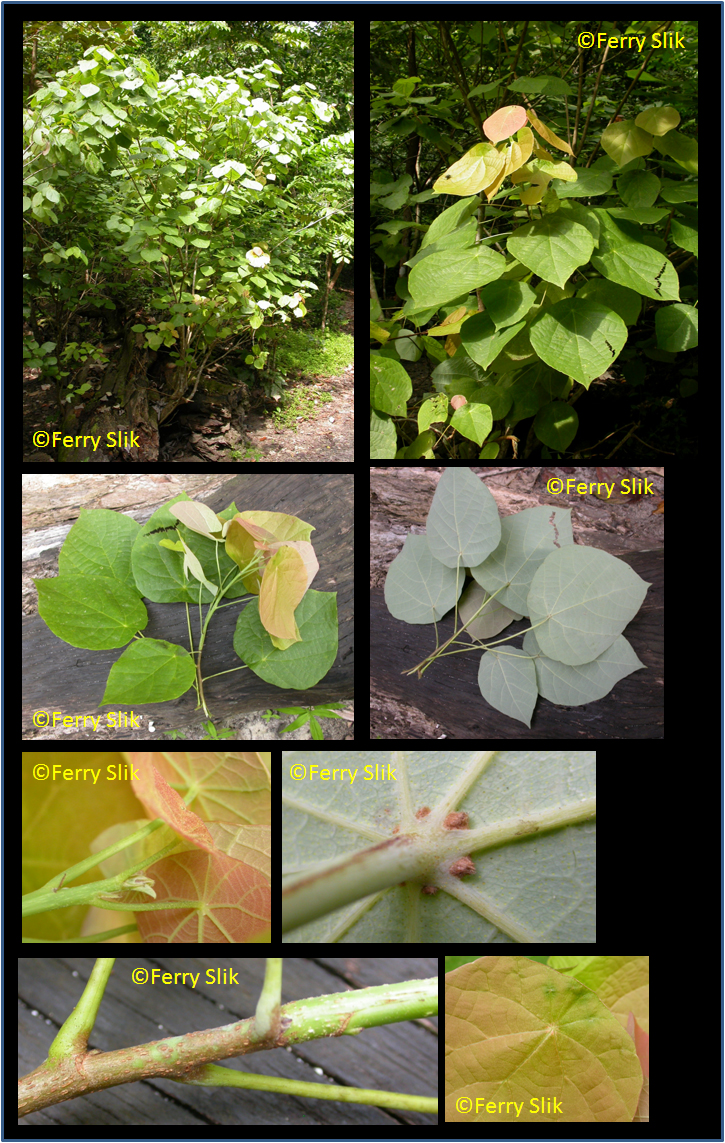Mallotus floribundus (Blume) Müll.Arg., Flora 47: 469 (1864)
Name meaning 'abundantly flowering'.Synonyms
Adisca floribunda Blume
Coelodiscus annamiticus (Kuntze) Gagnep.
Mallotus amentiformis Müll.Arg.
Mallotus annamiticus Kuntze
Mallotus floribundus var. genuinus Pax & K.Hoffm.
Mallotus floribundus var. pilosus Pax & K.Hoffm.
Mappa floribunda (Blume) Zoll. & Moritzi
Ricinus floribundus Reinw. ex Müll.Arg.
Ricinus tanarius Lour.
Rottlera floribunda (Blume) Hassk.
Description
Shrubs to small trees up to ca. 17 m tall and 29 cm dbh, reproductive from 4 m tall and 3 cm dbh. Twigs solid, glabrous. Stipules ovate,
usually early-caducous, erect, 1-2.5 mm long by 0.5-1.5 mm wide. Petioles glabrous, up to ca. 16 cm long. Leaves alternate, peltate,
ovate to orbicular, 12-19 cm long by 8.5-15 cm wide, length/width-ratio 1.04-1.90; secondary veins 4-6, ending in the margin; leaf base
rounded, peltate margin length 1-2 cm; leaf margin with glands; leaf upper surface glabrous, with 2-6 basal nectary glands on basal veins,
some distance from petiole insertion, sometimes with apical nectary glands; leaf lower surface glabrous, often slightly glaucous,
numerously gland dotted, with conspicuous hairy domatia at petiole insertion, sometimes also less conspicuous hair domatia higher along
the midrib. Staminate inflorescences not branched; flowers clustered per bracteole; bracteoles with entire margin. Pistillate inflorescences
not branched; fruits 13-18 mm wide, 3-locular, with few long, curly spines.
Ecology
Locally common in primary and secondary forests, mainly in open places; often found on river banks, along roads, in gaps, clearings, and
open fields; in badly drained swampy areas as well as in dry areas; on most soil types, from sandy to loamy to clayey to limestone.
Altitude: up to 500(–933) m.
Distribution
From Indochina to Indonesia, Papua New Guinea and the Solomon Islands. In Borneo it has been collected in Sarawak, Brunei,
Sabah, West- and East-Kalimantan.
Uses
The rather aromatic male flowers are used in Java with rice-flour in making scented medicinally applied powders. In Peninsular Malaysia
a decoction of the root is administered against fever, after child birth, and against stomachache and cholera. In Sumatra the tough wood
is used to make small objects. Cultivated as an ornamental in Burma.
